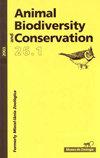Bold or shy? Examining the risk–taking behavior and neophobia of invasive and non–invasive house sparrows
IF 1
4区 环境科学与生态学
Q3 BIODIVERSITY CONSERVATION
引用次数: 5
Abstract
Behavior provides a useful framework for understanding specialization, with animal personality aiding our understanding of the invasiveness of birds. Invasions imply dispersion into unknown areas and could require changes in behavior or spatial clustering based on personality. Reduced neophobia and increased exploring behavior could allow individuals to colonize new areas as they test and use non–familiar resources. Here, we hypothesized that house sparrow (Passer domesticus) individuals from invasive populations would exhibit bolder behavior than in non–invasive populations. We assessed risk taking and neophobia in male house sparrows in Barcelona (where it is considered native) and in Mexico City (where it has become widely invasive), captured in two different habitats, urban and non–urban. We assessed latency to enter an experimental cage and to explore it, and latency to feed and feeding time in the presence of a novel object. We found that sparrows from Mexico City, both from urban and non–urban areas, were quicker to enter the experimental cage than the sparrows from Barcelona. The time it took the birds to start exploring the cage gave a similar result. We found no differences between cities or habitats in the latency to feed and feeding time while exposed to a novel object. Our results partially support the view that the invader populations from Mexico City are bolder than those from Barcelona. Behavior is an important component of plasticity and its variability may have an important effect on adaptation to local situations. Future studies should disentangle the underlying mechanisms that explain the different personalities found in populations of different regions, contrasting populations of different densities, and taking different food availability scenarios into account.大胆还是害羞?研究侵入性和非侵入性家麻雀的冒险行为和新恐惧症
行为为理解专业化提供了一个有用的框架,动物个性有助于我们理解鸟类的入侵性。入侵意味着分散到未知区域,可能需要改变行为或基于个性的空间聚类。减少新恐惧症和增加探索行为可以让个体在测试和使用不熟悉的资源时开拓新的领域。在这里,我们假设来自入侵种群的家雀个体会比非入侵种群表现出更大胆的行为。我们评估了在巴塞罗那(它被认为是本地的)和墨西哥城(它已经变得广泛入侵)的雄性室内麻雀的冒险和新恐惧症,它们在城市和非城市两个不同的栖息地被捕获。我们评估了进入实验笼并探索它的潜伏期,以及在新物体存在的情况下进食的潜伏期和进食时间。我们发现,来自墨西哥城的麻雀,无论是来自城市还是非城市地区,都比来自巴塞罗那的麻雀更快地进入实验笼。鸟类开始探索笼子的时间也产生了类似的结果。我们发现,城市或栖息地在接触新物体时的进食延迟和进食时间方面没有差异。我们的研究结果部分支持了这样一种观点,即来自墨西哥城的入侵者比来自巴塞罗那的入侵者更大胆。行为是可塑性的重要组成部分,其可变性可能对适应局部情况产生重要影响。未来的研究应该理清解释不同地区人群不同性格的潜在机制,对比不同密度的人群,并考虑不同的食物供应情况。
本文章由计算机程序翻译,如有差异,请以英文原文为准。
求助全文
约1分钟内获得全文
求助全文
来源期刊

Animal Biodiversity and Conservation
农林科学-动物学
CiteScore
2.00
自引率
0.00%
发文量
21
审稿时长
>12 weeks
期刊介绍:
Animal Biodiversity and Conservation (antes Miscel·lània Zoològica) es una revista interdisciplinar, publicada desde 1958 por el Museu de Ciències Naturals de Barcelona. Incluye artículos de investigación empírica y teórica en todas las áreas de la zoología (sistemática, taxonomía, morfología, biogeografía, ecología, etología, fisiología y genética) procedentes de todas las regiones del mundo. La revista presta especial interés a los estudios que planteen un problema nuevo o introduzcan un tema nuevo, con hipòtesis y prediccions claras, y a los trabajos que de una manera u otra tengan relevancia en la biología de la conservación. No se publicaran artículos puramente descriptivos, o artículos faunísticos o corológicos en los que se describa la distribución en el espacio o en el tiempo de los organismes zoológicos.
 求助内容:
求助内容: 应助结果提醒方式:
应助结果提醒方式:


